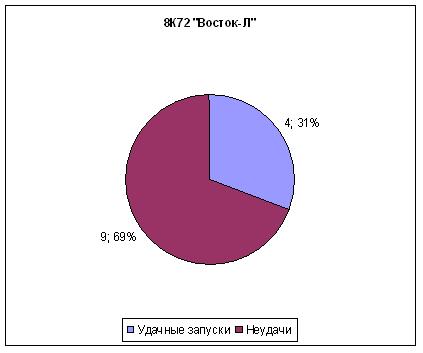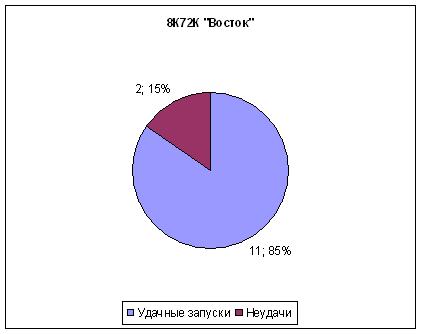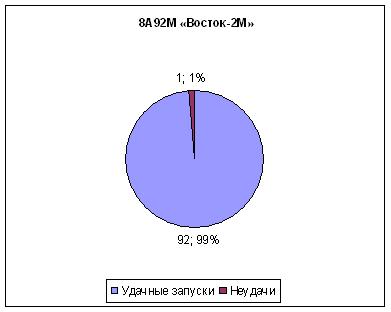Launch vehicle launch statistics in the USSR and the Russian Federation: part two. East
So, in the continuation of a small review of the Proton series carrier rockets , let us consider the history of perhaps the most famous carrier Vostok. Yes, yes, that same “Vostok”, which put animals and people into orbit, and thanks to the successful launch of which we have a wonderful celebration of the Day of Astronautics.
Actually, the Vostok launch vehicle is at the dawn of mass space launches in the USSR. It was he who brought the first satellites (more precisely, the first satellite was derived by the PH series R-7, which formed the basis of the East), the first living organisms, was the main RN in the program of research of the Moon, as well as in the program for launching spy satellites.
The first modification of the PH had the code 8K72, codename "Vostok-L", but was also called the Luna carrier rocket. However, the statistics of its launches was very sad (here and later on the graphs indicate the number and percentage of successful and unsuccessful launches) :

Although it is worth noting that the automatic interplanetary stations Luna-2 and Luna-3 were nevertheless successfully delivered to the Moon.
Well, of course, it is impossible not to note the successful launch of living organisms into space on April 19, 1960 - the famous Belka and Strelka successfully launched and reached the Earth's orbit (and later they successfully landed). The last launch (also successful, with dogs on board) took place on December 1, 1960.
Unfortunately, the first launch with living creatures, the Chaika and Chanterelle dogs, turned out to be emergency.
It was the possibility of a safe journey to orbit and back for a person that gave a qualitative impetus (if not purely political reasons, of course) to the development of the industry, which led to an improvement in the LV. So, already on December 22, 1960, according to the Vostok program, it made the first launch (unsuccessful, alas) of a device with a modified RV 8K72K Vostok. The main modification is an upgraded third stage.

As you can see, here the percentage of successful launches is already significantly higher. The total number of launches is 13, which, of course, is not enough for reliable statistics, but based on them we get 15% of failures. Given the fact that it was 8K72K that put Yuri Gagarin into orbit, it was really a risky event (although not as much as for Belka and Strelka). The Vostok launch vehicle delivered the cargo to orbit until July 10, 1964.
')
Further launches of the series are already connected with the PH 8A92 "Vostok-2". From the information found in the public domain, it is not clear what the fundamental difference was between Vostok-2 and Vostok. But since Vostok-2 drove mainly satellites, rather than space ships, then most likely modifications were made for this task. It is worth noting that the RN was quite in demand (until the year 67, it was he who carried the Zenith space reconnaissance satellites into orbit). The statistics are already better, but still leaves much to be desired:

Vostok-2 completed its flight history on May 12, 1967 after transferring Zenits to another PH 11A57.
Meanwhile, the PH 8A92M Vostok-2M was already actively flying, which is already a major modification of its forerunner. The engines were modified, the specific impulse was seriously increased, the control system was completely reworked, which was already assembled on completely semiconductor devices, which greatly facilitated its specific weight.
The launches began on August 28, 1964, and continued until August 29, 1991. For twenty-seven years, ninety-three launches, there was only one emergency (!!!). At least according to official figures. The chart looks quite nice and nice:

And a bit of comparison with Proton series PH:
1. The starting mass of the East is 290 tons. The starting mass of the Proton is 710 tons.
2. The payload of the East - 4.7 tons. The payload of the Proton - 3.7 - 23 tons (depending on the orbit)
3. The failure rate: East - 1.08%, Proton-K - 10.93%, Proton-M - 10.81%.
Thus, despite the significantly greater reliability of the Vostok-2M, the Proton-K was actively used in the same years. Most likely this is due to indicators of payload. If rough, the Protons carry more and higher, which affects their weight and, apparently, the complexity of the design, which leads to more frequent failures.
The second interesting observation is the following. If we take the percentage of failures of the Proton and Vostok series PHs for 10 years in the period of confident rocket building (we take 80s), then we get 0% of failures of Vostok-2M and 3.88% of failures of Proton-K ".
And if you take 10 years of operation "Proton-M" (slightly more, 12 actually), then we get 10.83% of failures. Many habrovchane pointed to the frequency of accidents specifically for GLONASS (which, by the way is debatable, simply GLONASS was more highlighted), implying sabotage and sabotage, many pointed to obvious personnel problems in the field, but be that as it may, even on the basis of two launch vehicles it is clear that in the space industry we now have a very strong backlog from ourselves 30-40 years ago.
Actually, the Vostok launch vehicle is at the dawn of mass space launches in the USSR. It was he who brought the first satellites (more precisely, the first satellite was derived by the PH series R-7, which formed the basis of the East), the first living organisms, was the main RN in the program of research of the Moon, as well as in the program for launching spy satellites.
The first modification of the PH had the code 8K72, codename "Vostok-L", but was also called the Luna carrier rocket. However, the statistics of its launches was very sad (here and later on the graphs indicate the number and percentage of successful and unsuccessful launches) :

Although it is worth noting that the automatic interplanetary stations Luna-2 and Luna-3 were nevertheless successfully delivered to the Moon.
Well, of course, it is impossible not to note the successful launch of living organisms into space on April 19, 1960 - the famous Belka and Strelka successfully launched and reached the Earth's orbit (and later they successfully landed). The last launch (also successful, with dogs on board) took place on December 1, 1960.
Unfortunately, the first launch with living creatures, the Chaika and Chanterelle dogs, turned out to be emergency.
It was the possibility of a safe journey to orbit and back for a person that gave a qualitative impetus (if not purely political reasons, of course) to the development of the industry, which led to an improvement in the LV. So, already on December 22, 1960, according to the Vostok program, it made the first launch (unsuccessful, alas) of a device with a modified RV 8K72K Vostok. The main modification is an upgraded third stage.

As you can see, here the percentage of successful launches is already significantly higher. The total number of launches is 13, which, of course, is not enough for reliable statistics, but based on them we get 15% of failures. Given the fact that it was 8K72K that put Yuri Gagarin into orbit, it was really a risky event (although not as much as for Belka and Strelka). The Vostok launch vehicle delivered the cargo to orbit until July 10, 1964.
')
Further launches of the series are already connected with the PH 8A92 "Vostok-2". From the information found in the public domain, it is not clear what the fundamental difference was between Vostok-2 and Vostok. But since Vostok-2 drove mainly satellites, rather than space ships, then most likely modifications were made for this task. It is worth noting that the RN was quite in demand (until the year 67, it was he who carried the Zenith space reconnaissance satellites into orbit). The statistics are already better, but still leaves much to be desired:

Vostok-2 completed its flight history on May 12, 1967 after transferring Zenits to another PH 11A57.
Meanwhile, the PH 8A92M Vostok-2M was already actively flying, which is already a major modification of its forerunner. The engines were modified, the specific impulse was seriously increased, the control system was completely reworked, which was already assembled on completely semiconductor devices, which greatly facilitated its specific weight.
The launches began on August 28, 1964, and continued until August 29, 1991. For twenty-seven years, ninety-three launches, there was only one emergency (!!!). At least according to official figures. The chart looks quite nice and nice:

And a bit of comparison with Proton series PH:
1. The starting mass of the East is 290 tons. The starting mass of the Proton is 710 tons.
2. The payload of the East - 4.7 tons. The payload of the Proton - 3.7 - 23 tons (depending on the orbit)
3. The failure rate: East - 1.08%, Proton-K - 10.93%, Proton-M - 10.81%.
Thus, despite the significantly greater reliability of the Vostok-2M, the Proton-K was actively used in the same years. Most likely this is due to indicators of payload. If rough, the Protons carry more and higher, which affects their weight and, apparently, the complexity of the design, which leads to more frequent failures.
The second interesting observation is the following. If we take the percentage of failures of the Proton and Vostok series PHs for 10 years in the period of confident rocket building (we take 80s), then we get 0% of failures of Vostok-2M and 3.88% of failures of Proton-K ".
And if you take 10 years of operation "Proton-M" (slightly more, 12 actually), then we get 10.83% of failures. Many habrovchane pointed to the frequency of accidents specifically for GLONASS (which, by the way is debatable, simply GLONASS was more highlighted), implying sabotage and sabotage, many pointed to obvious personnel problems in the field, but be that as it may, even on the basis of two launch vehicles it is clear that in the space industry we now have a very strong backlog from ourselves 30-40 years ago.
Source: https://habr.com/ru/post/185906/
All Articles